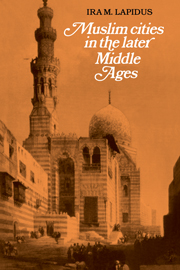Book contents
- Frontmatter
- Contents
- PREFACE
- INTRODUCTION
- CHAPTER I A HISTORY OF CITIES IN THE MAMLUK EMPIRE
- CHAPTER II THE MAMLUK REGIME IN THE LIFE OF THE CITIES
- CHAPTER III THE URBAN SOCIETY
- CHAPTER IV THE POLITICAL SYSTEM: THE MAMLUK STATE AND THE URBAN NOTABLES
- CHAPTER V THE POLITICAL SYSTEM: THE COMMON PEOPLE BETWEEN VIOLENCE AND IMPOTENCE
- CHAPTER VI CONCLUSION: SOCIETY AND POLITY IN MEDIEVAL MUSLIM CITIES
- BIBLIOGRAPHICAL NOTES
- INDEX
CHAPTER I - A HISTORY OF CITIES IN THE MAMLUK EMPIRE
Published online by Cambridge University Press: 24 November 2009
- Frontmatter
- Contents
- PREFACE
- INTRODUCTION
- CHAPTER I A HISTORY OF CITIES IN THE MAMLUK EMPIRE
- CHAPTER II THE MAMLUK REGIME IN THE LIFE OF THE CITIES
- CHAPTER III THE URBAN SOCIETY
- CHAPTER IV THE POLITICAL SYSTEM: THE MAMLUK STATE AND THE URBAN NOTABLES
- CHAPTER V THE POLITICAL SYSTEM: THE COMMON PEOPLE BETWEEN VIOLENCE AND IMPOTENCE
- CHAPTER VI CONCLUSION: SOCIETY AND POLITY IN MEDIEVAL MUSLIM CITIES
- BIBLIOGRAPHICAL NOTES
- INDEX
Summary
In 1250 a palace coup snuffed out the Ayyūbid house which had ruled Egypt since the time of Saladin (1169–1193), and brought to the throne of the Sultans the chiefs of Mamluk regiments who were already the effective if not the recognized masters of the state. The moment was surely unpropitious for the establishment of a new regime, and not without enormous effort was its survival secured. Threatened by both Mongol invasions and Christian crusades and weakened internally because of their tainted possession of power, the Mamluks waged relentless wars against both the Mongols and the crusader principalities for over fifty years. By 1312 the greatest danger had passed on both fronts and the Mamluk Empire entered a period of stable prosperity which was to last almost until the end of the century. A peaceful and prosperous period, brilliant in cultural as well as economic attainments, succeeded the hardships of the first half century. This most splendid era in turn came to an end about 1388, when the ambitions of ruthless Mamluk factions plunged the empire into a quarter century of unrelieved civil wars. The weakness of the state encouraged bedouin and nomadic rebellions and Tatar and Christian assaults. In 1400 Tamerlane devastated Aleppo and Damascus while Christian pirates ceaselessly plagued Muslim shipping and coastal regions. Only from 1422, after the advent of Sultan Barsbāy, was order finally restored.
- Type
- Chapter
- Information
- Muslim Cities in the Later Middle Ages , pp. 9 - 43Publisher: Cambridge University PressPrint publication year: 1984



